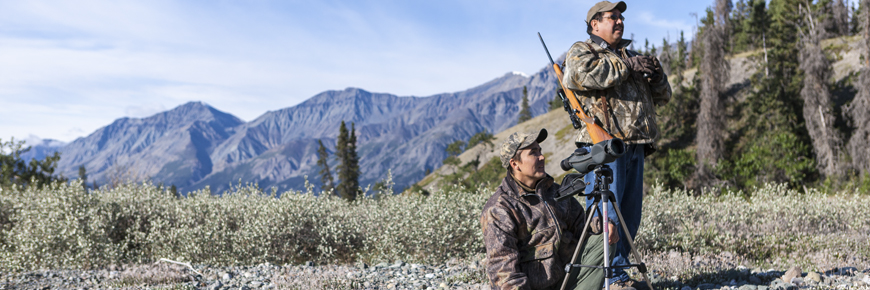
Harvesting - First Nations Rights and Responsibilities
Kluane National Park and Reserve
Special Recognition | Final Agreements | Background | Baikal Sedge | Guiding Principles | Harvesting Rights and Responsibilities | Preparing for Harvesting in KNPR | After a Succesful Hunt in KNPR | Hunting and Visitors | Heritage Resources | Contact Information
Printable Version
You can download the informatinon found on this web page in PDF format.
Special Recognition
The rights of citizens of Champagne and Aishihik First Nations and Kluane First Nation to harvest all species of fish, wildlife, and edible plants in Kluane National Park and Reserve are protected under the Constitution of Canada.

Welcome to Kluane National Park and Reserve (KNPR). This area is an important part of the traditional territories of Champagne and Aishihik First Nations (CAFN), and Kluane First Nation (KFN) and continues to be highly valued for its abundance and diversity of northern plant, fish, and wildlife populations. Today, KNPR is managed cooperatively with CAFN and KFN who maintain a deep cultural and spiritual relationship with the land.
This web page is intended to summarize the harvesting rights of CAFN and KFN citizens as well as to promote safe and responsible harvesting practices within KNPR to ensure visitor safety.
Final Agreements
Champagne and Aishihik First Nations Final Agreement - Chapter 10 – Special Management Areas – Schedule A – Kluane National Park – Section 4.0 outlines the harvesting rights and responsibilities of Champagne and Aishihik First Nations people in the Park Reserve. Champagne and Aishihik people shall have the exclusive right to Harvest for Subsistence within the CAFN Region, all species of Fish and Wildlife for themselves and their families in all seasons of the year and in any numbers, subject only to limitations prescribed pursuant to this schedule.

Kluane First Nation Final Agreement - Chapter 10 – Special Management Areas – Schedule C – Kluane National Park and Park Reserve – Section 4.0 outlines the harvesting rights and responsibilities of Kluane First Nation people in the Park Reserve. Kluane People shall have the right to Harvest for Subsistence within the Tachäl Region, all species of Fish and Wildlife for themselves and their families in all seasons of the year and in any numbers, subject only to limitations prescribed pursuant to this schedule, and that right shall become exclusive to Kluane people on the coming into effect of a White River First Nation Final Agreement.
For more detail, please consult the appropriate First Nations’ Final Agreement or contact your local First Nations’ office.
Background
Nän käy shäwthǟn uk’ats’änáta - The earth, take care of it
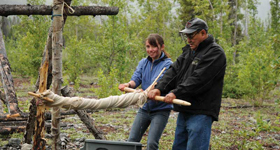
The Kluane region has long been a traditional gathering place for Southern Tutchone people. For thousands of years, Dän (indigenous people) pursued a subsistence-hunting and gathering lifestyle throughout much of the region now called Kluane National Park and Reserve (KNPR). In 1943, the Canadian government set aside this area as a game sanctuary to protect local wildlife, a move that also effectively banned First Nations from hunting and trapping and pursuing their subsistence lifestyle. A portion of the Kluane Game Sanctuary became what is now Kluane National Park and Reserve in 1973, but First Nations understanding of their subsistence harvesting rights within the park boundary remained somewhat uncertain until further clarity was brought to the matter with the signing of the CAFN comprehensive agreement in 1993, and later, the KFN comprehensive agreement in 2003. Through the signing of these agreements, the Canadian government finally recognized formally that CAFN and KFN citizens have subsistence harvesting rights on their traditional lands in KNPR.
The lack of harvesting by the area’s indigenous peoples in the game sanctuary and later the park has had serious and lasting effects on First Nations’ culture and livelihood’s, as well as adversely impacting the region’s ecosystem. First Nations and subsistence harvesting are an integral part of the ecological integrity of Kluane National Park and Reserve and the greater Kluane region.

Baikal Sedge
As this plant is threatened and sensitive to disturbance, CAFN citizens are asked to exercise caution when accessing the Alsek Dune area, located at the confluence of the Dezadeash and Kaskawulsh Rivers.
Guiding Principles
CAFN and KFN governments encourage all subsistence harvesters to follow their traditional practices of caring for and respecting the land and its inhabitants.
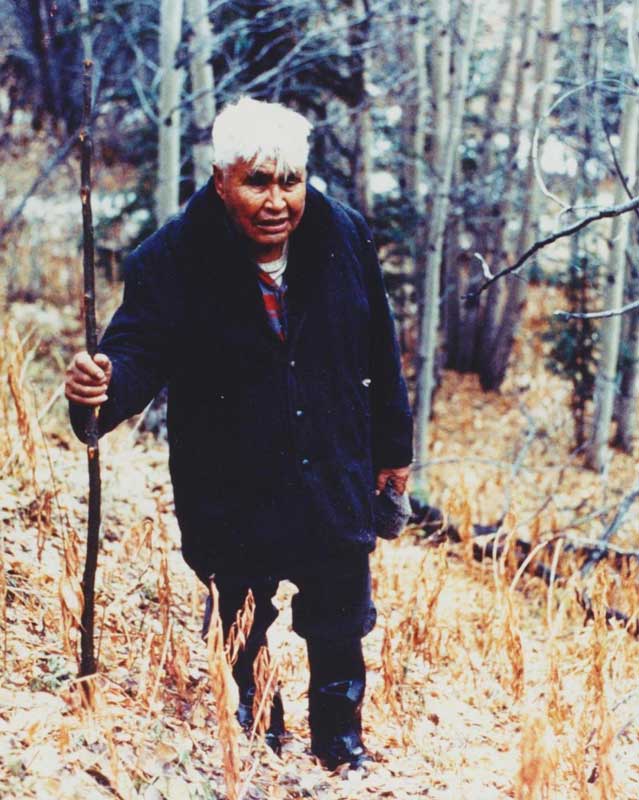
- Take only what you can use and use all that you take;
- Respect the rights of other KNPR users and encourage public understanding, appreciation and enjoyment of the park;
- Please carry out your harvesting activities in a respectful manner, and be considerate and respectful of each others use;
- Practice safe and responsible harvesting that will minimize encounters with wildlife and ensure public safety;
- Leave the land in the same condition or better than you found it;
- Citizens of CAFN and KFN have the right to use both traditional and current methods and equipment for subsistence harvesting within KNPR, which may include snowmobiles and ATVs.
Please remember, your harvesting rights only apply within your respective traditional territory of KNPR, and you are also reminded to observe the No Harvest Zones (see Map).
Harvesting Rights and Responsibilities

Harvesting in KNPR means hunting, trapping, fishing, or gathering plants and includes travel and camping associated with harvesting activities. Harvesting methods have evolved over time and CAFN and KFN citizens may harvest using traditional or modern equipment and technologies such as firearms, motorized vehicles, GPS, etc. CAFN citizens are asked to observe the Voluntary No Discharge of Firearms Zone within 1 km of the Kathleen Lake Campground.
As provided for in Chapter 10, Schedule A (CAFN) & Schedule C (KFN) of the First Nations’ Final Agreements, CAFN and KFN citizen harvesting may occur:
- for all fish, wildlife and plants for yourself, family and for ceremonial purposes
- using traditional and/or current methods and equipment
- year round in the First Nations defined territory (see Map for traditional territory boundaries and No Harvest Zones);
- for trees, as needed for harvesting activities (ie. Building temporary brush huts, campfires, etc)
CAFN and KFN subsistence harvesters also have the right:
- to share, trade, barter or sell any edible fish, wildlife and plant products with each other and other Yukon First Nations for domestic purposes.
- to give, trade, barter or sell (in the case of traditionally produced handicrafts or as associated with harvesting furbearers) any non edible by-product of fish and wildlife to any person.
Please note that all harvesting is subject to restrictions pertaining to public health and safety, and conservation. There are currently 3 No-Harvest Zones in the park that restrict harvesting. Please contact your local First Nations office for more information.
Preparing for Harvesting in KNPR
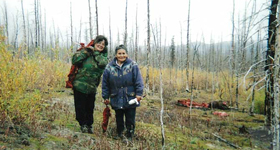
While harvesting is often spontaneous, Parks Canada is requesting First Nation harvesters to inform KNPR staff in advance of any planned wildlife harvesting activities within the park. This is not a requirement, but rather a request that will allow parks staff to notify other users and reduce the likelihood of human-bear and other wildlife conflicts. Contact information for KNPR is provided at the end of this web page.
No permit is required for CAFN and KFN citizens exercising their harvesting rights within the park; however, you should carry proof of enrollment from your respective First Nation while harvesting in KNPR, as it may be requested by a Park Warden or enforcement officer.
After a Succesful Hunt in KNPR
CAFN and KFN citizens are asked to report successful harvest within KNPR to their local First Nations offices. This information will allow for better monitoring and management of resources within the park, by both the First Nations governments and by Parks Canada. We are also requesting that you report successful wildlife harvest directly to KNPR as soon as possible so that parks staff can help mitigate any possible public safety concerns (eg: hikers coming across a kill site with bear activity).
Hunting and Visitors
Please remember that some areas in KNPR attract a high number of visitors in the summer months. Visitors may be very curious about First Nations culture, and harvesting activities in particular.
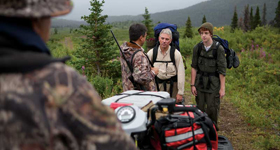
- Visitors to the park are being asked to make themselves known to the harvester and not to approach unless invited to. Should the visitor decide to approach, they have been asked to exercise caution, be respectful, polite, and courteous and if the harvester indicates they do not want company, that the visitor leaves the area. Please notify KNPR staff if you have any concerns about visitors’ attitudes or behaviors associated with your subsistence harvesting activities.
- The harvester is asked to observe the same considerations; being respectful, polite and courteous if approached by a visitor. The harvester may also choose to identify themselves and state they are exercising their harvesting rights, but are not required to do so.
Heritage Resources
A Land Rich in History, A Land That Provides
First Nations have occupied this landscape for time immemorial. As a result, there are numerous historic sites and artifacts in the park. Common types of heritage sites and signs that can be found in KNPR include:
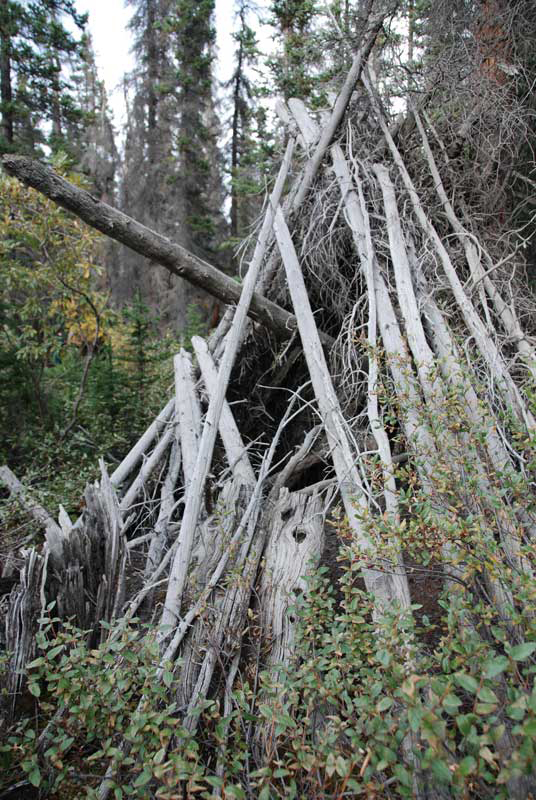
- Brush houses, brush shelters and drying racks
- Trail blazes/markers
- Cabins, caches and dog houses
- Campsites with old pots, pans, traps and mining equipment
- Archaeological sites with stone tools (scarpers, spear points, etc.) and flakes left behind when making stone tools
- Evidence of old fireplaces (cracked rocks, small fragments of cooked bone)
- Piles of rocks covered with lichen (especially in the high subapline country), indicating hunting blinds, caches, or trails/routes.
Heritage sites in the park are protected and are not to be disturbed. Please respect these sites by leaving them in the same condition as they are found. Do not collect artifacts, burn stumps or wooden structures or remains. If you see something unusual, please report it to KNPR staff or First Nation staff and if possible GPS and take images of the location.
Contact Information
Please contact the appropriate office for further information related to harvesting, or for help planning your harvesting activities in KNPR.
Champagne and Aishihik First Nations
#1 Allen Place
PO Box 5310, Haines Junction, Yukon, Y0B 1L0
CAFN Renewable Resources
(867) 634-4248 or 634-4211
CAFN Lands (867) 634-4231
CAFN Heritage (867) 634-3308
Fax # (867) 634-2108
Kluane First Nation
#15 Sedata Street
PO Box 20, Burwash Landing, Yukon, Y0B 1V0
KFN Main Office (867) 841-4274
Fax # (867) 841-5900
Kluane National Park and Reserve
119 Logan Place
PO Box 5495, Haines Junction, Yukon, Y0B 1L0
Main Switchboard (867) 634-7250
Resource Conservation & Park Warden Office (867) 634-7279
Parks Canada 24-Hour Emergency Dispatch (877) 852-3100
Visitor Center Front Desk (867) 634-7207
Fax # (867) 634-7208
This information was a joint initiative developed in co-operation by Champagne and Aishihik First Nations, Kluane First Nation, Kluane National Park & Reserve, and Kluane Park Management Board.
Related links
- Date modified :
